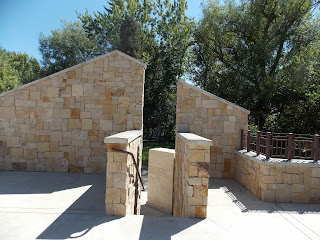We first saw large sand dunes and then what looked like a dried lake bed. Checking our AAA tour book we learned that we were at the base of Abert Rim, one of the highest exposed fault scarps (steep slopes) in North America. The 2000-foot-high escarpment is great for hang gliding.
Highway 395 also brought us through the the Goose Lake recreational area, into California. That lake, as well as other lakes in the region, were vestiges of prehistoric Lake Chewaucan. That probably explains the dry sea beds and alkali flats which we had been seeing. We had no choice as to where to stop for the night, there was only one trailer park in Likely, California. The town had a couple of buildings; "Most Unlikely Cafe" and a community church. The trailer park was out of town a distance, in a remote area surrounded by cattle ranches. The travel guide said it was a golf resort, besides a park for trailers and motor homes. How likely was that, we wondered, as we drove up to the park and saw no golf courses, or the presence of a restaurant that was supposed to be there.
After we had parked our rig and got settled for the night, I walked the perimeter of the park. Found the golf course and the restaurant which was closed for the day. No activity anywhere, however. I still wondered if the "resort" part of this park was a thing of the past. But no, as I was again hiking around the park the next morning, a parade of golf carts passed me heading to the links.
I thought we were going to have the same scenery on Saturday as the past two days, but the land along the highway started greening up with plant life other than sage and juniper. What a beautiful sight to see fields covered with black-eyed susans! We started now seeing fields covered with a variety of crops. We also noticed that the highway was following a creek.We also started seeing what we thought was the backside of the Sierra Mountains, covered still with small patches of snow on top. We passed up Reno and went 30 miles further to Carson City, just for the reason that we wanted to see the capital of Nevada. It is a few degrees cooler there, also.



















































